Adrian Collins's Blog, page 122
September 27, 2022
REVIEW: Arvekt by Craig Lea Gordon
Arvekt by Craig Lea Gordon is a kinetic action-filled cyberpunk thriller that I absolutely love. If anyone knows anything about me, they’ll know that I am a huge fan of the cyberpunk genre. It is my favorite thing to read and write alongside superhero fiction. However, there’s a lot of what I term to be “falsely advertised” cyberpunk that claims to be about the gritty dark dystopian futures of the world with transhumanist themes but is usually just Lit-RPG by another name. There’s plenty of good Lit-RPG out there but very little of it is cyberpunk.
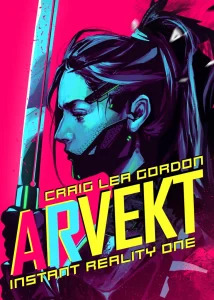 I’m pleased to say Arkvekt is the exception to this rule as it is a fantastic novel that is square within the hole of what I consider to be “true cyberpunk.” It is a bit more Ghost in the Shell than William Gibson but I don’t consider that a bad thing. Cyberpunk can be a bunch of crazy borged-out ninjas fighting government conspiracies just as much as it can be dark and skeevy alleyways where people have more implants than food.
I’m pleased to say Arkvekt is the exception to this rule as it is a fantastic novel that is square within the hole of what I consider to be “true cyberpunk.” It is a bit more Ghost in the Shell than William Gibson but I don’t consider that a bad thing. Cyberpunk can be a bunch of crazy borged-out ninjas fighting government conspiracies just as much as it can be dark and skeevy alleyways where people have more implants than food.
The premise is that Tannis Ord is a young soldier working for a mysterious black ops organization that protects the world from hackers as well as AI cultists and terrorists. It’s a brutal business and Tannis has a history of mental illness that has seemingly not stood in her way of continuing to serve as their assassin. Apparently, the Director just thinks they can erase the trauma and related issues with a wave of their hand.
Something is rotten in the state of the future, though, and Tannis can’t help but question her reality. In what is probably a nod to The Matrix but actually the more practical Augmented Reality, she struggles with seeing things that are not there as well as gaps in her memory. It could be related to her previous breakdowns or it might be her mind rebelling against the reality that she has been presented.
In Arvekt, Tannis is not the only character, though, and there’s multiple other interesting individuals trying to deal with the sense that things are not as they seem. My favorite is a Senator for the world government that is absolutely hell bent against giving the control of the world to the mysterious Ix that already runs the vast majority of the world’s functions. Indeed, I like that he’s as perplexed as anyone as to why so many people want to do it in the first place.
Arvekt is a book filled with twists, turns, fake-outs, and illusions. Many times I thought I had a handle on where the book was going, only for it to surprise me by revealing it was going someplace entirely different. I occasionally got lost in the technology and jargon but that helped make the book feel like it was taking place in a wholly different world.
Read Arvekt by Craig Lea GordonThe post REVIEW: Arvekt by Craig Lea Gordon appeared first on Grimdark Magazine.
September 26, 2022
REVIEW: One Dark Window by Rachel Gillig
One Dark Window is the debut fantasy novel from Rachel Gillig. From Orbit Books, it is the first novel in a duology with gothic elements and some romance. Although not particularly grim, it is a dark fantasy so may hold some appeal to readers of Grimdark Magazine. I certainly enjoyed reading it, and it would probably also appeal to those who enjoyed Alexis Henderson’s The Year of the Witching or Naomi Novik’s Uprooted.
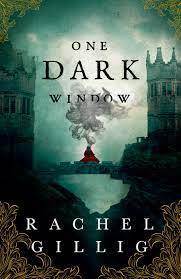 One Dark Window follows Elspeth Spindle, a survivor of a mysterious fever which has left her with magical abilities. In Blunder, hiding someone who has had the fever is treason and punishable by death. After surviving the fever one is deemed to be tainted, so death also awaits. As a result Elspeth and her family are understandably wary, hiding her away from society. As well as hiding their capital crimes the fever has marked Elspeth – she has an ancient mercurial spirit trapped inside her mind. The second, and legally sanctioned, form of magic in Gillig’s world is through the power of Providence Cards, a deck of magical cards with each card giving its bearer different abilities. However this magic also has a cost, and the creation of the deck of Providence Cards and their subsequent separation has plunged Blunder into ruin – with a mist blighting crops and driving people mad, as well as the ruinous fever. Elspeth accidentally becomes embroiled in a dangerous quest to reunite the deck and free Blunder from the dark magic infecting it. The question is, will she be able to do so before the monster in her mind takes over her completely?
One Dark Window follows Elspeth Spindle, a survivor of a mysterious fever which has left her with magical abilities. In Blunder, hiding someone who has had the fever is treason and punishable by death. After surviving the fever one is deemed to be tainted, so death also awaits. As a result Elspeth and her family are understandably wary, hiding her away from society. As well as hiding their capital crimes the fever has marked Elspeth – she has an ancient mercurial spirit trapped inside her mind. The second, and legally sanctioned, form of magic in Gillig’s world is through the power of Providence Cards, a deck of magical cards with each card giving its bearer different abilities. However this magic also has a cost, and the creation of the deck of Providence Cards and their subsequent separation has plunged Blunder into ruin – with a mist blighting crops and driving people mad, as well as the ruinous fever. Elspeth accidentally becomes embroiled in a dangerous quest to reunite the deck and free Blunder from the dark magic infecting it. The question is, will she be able to do so before the monster in her mind takes over her completely?
I liked Gillig’s One Dark Window. I was intrigued by the idea of Providence Cards and really enjoyed learning more about them through the ornate chapter headers and Gillig’s lush writing. However I do think this novel as a whole is on the gentle end of dark fantasy, and even with the romantic elements of the plot I would not describe it as a romance either. I would put One Dark Window in the cosy section of my bookshelf; it is an easy read with characters I care about and a plot I was invested in. Gillig’s writing is atmospheric, undeniably beautiful and the world building and explanation of the magical structures is done very well. It definitely has some darkness, a gothic allure, and a fairy tale feel (Grimm not Disney) but none of these elements are particularly superlative. This is the sort of book I would look forward to curling up with on a rainy day with a warm beverage for an afternoon of darkish escapism. I am not sure if darkish fantasy exists as a subgenre (if it does it definitely has a time and a place in my reading life) but if someone is picking this up hoping for an adult gothic horror novel they will be disappointed.
I will admit that when I started One Dark Window I was expecting it to be a lot darker than it turned out. I had to adjust my expectations whilst reading and although I did end up liking it, over all I think I would have preferred to know in advance that this was a more moderate read. However I am still invested and am looking forward to the final instalment so all told it was worth the reading outlay.
Thank you very much to Rachel Gillig and the team over at Orbit for providing me with an ARC so that I can provide a review for Grimdark Magazine. 3/5.
Read One Dark Window by Rachel GilligThe post REVIEW: One Dark Window by Rachel Gillig appeared first on Grimdark Magazine.
REVIEW: The Rings of Power – Episode Five
The Rings of Power E5 is an improvement on last week but keeps with the slow pace of the series. The Harfoots and The Stranger return this week and all of the major characters have something to do as their paths get ready to merge. More questions emerge instead of the answers that are needed for this series to spark into life and be the must-see TV that a show based on Tolkien’s work should be. Still, there are many positives and the show is heading in the right direction.
It’s good to see the Harfoots return this week – frustrating accents aside – and there is a lovely sequence detailing their journey with an original song that feels as close to the essence of Tolkien’s work as we have seen in The Rings of Power so far. The lyrics of the song remind us that not all those who wander are lost is a throwback to the letter Gandalf writes to Frodo regarding Aragorn and gives me more confidence that the showrunners know what they are doing. There are still a lot of questions around The Stranger as we see more of his power and are left wondering, like him, whether he is a force for good or evil. The lack of control of his power certainly raises some questions in a show that is full of them. A new cult tracking The Stranger adds a further level of interest in the storyline but hopefully the show will start to answer the many questions it has set up over the past 5 episodes.
The Numenor storyline crawls forward as Galadriel attempts to push Halbrand to head to the Southlands and lead his people. She shows her skill with a blade by taking on numerous soldiers before one of them finally manages to get the smallest of touches on her. Isildur continues to be confusing in The Rings of Power E5 as he seems to annoy everyone around him but saves the scheming Kemen but for some reason doesn’t tell his father about Kemen setting fire to the ships. It’s an unusual move but we’ll see how it plays out. The ships finally head to the Southlands where the humans have been divided by those wishing to stand and fight and those who have decided to bend the knee to Adar who takes offence at being called Sauron. Next week should be a turning point for these two big threads as the series can finally pick up the pace with a battle to show off all the money that has been thrown at it.
Yet again, the relationship between Durin and Elrond is a highlight of the show. The Rings of Power E5 has Elrond prove how much his honour and the friendship means to him by keeping his oath even when interrogated by the High King of the Elves. Durin brings laughter and joy to the show with a lie about a table and its importance to his people. The friendship between the two is wholesome and again, is a reminder that the showrunners know what makes Tolkien’s work so special – its heart. A mention of the Silmarils, a Balrog of Morgoth, and the light of the Elves all go to show that the history of the world is important and perhaps the show is starting to find its footing.
Another slow episode but one that feels more assured than last week. The Rings of Power E5 works best when delving into the relationships between the various characters in the show and the way in which they react to fear and darkness. Difficult choices are made, choices that will set these characters on a path to be a part of some of the defining moments in the history of Middle-earth. There are more questions in The Rings of Power E5 but at least I still want to find out the answers.
Watch The Rings of Power on Amazon Prime.
The post REVIEW: The Rings of Power – Episode Five appeared first on Grimdark Magazine.
September 25, 2022
REVIEW: The Wraithbone Phoenix by Alec Worley
What do you get when you mix Ocean’s 11, Indiana Jones, Tomb Raider, and Warhammer 40k together? The Wraithbone Phoenix by Alec Worley. In this fun, reasonably light, treasure hunting, Astra militarium (I can’t break the habit of calling them the Guard) action book, we follow Baggit and Clodde and a host of other characters as they chase the riches of the mysterious Wraithbone Phoenix.
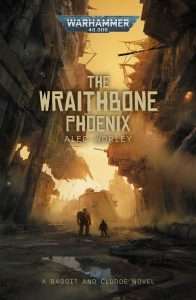 Herbo Prongfork, a ratling (essentially a hobbit in the 41st millennium), is a chef aboard a great warship, Sunstriker. In one moment he is both gloried and reviled by the humans he calls master, and in that moment a spark of rebellion is ignited that will echo throughout the ages.
Herbo Prongfork, a ratling (essentially a hobbit in the 41st millennium), is a chef aboard a great warship, Sunstriker. In one moment he is both gloried and reviled by the humans he calls master, and in that moment a spark of rebellion is ignited that will echo throughout the ages.
Centuries later, Baggit, also a ratling, is a ne’er do well running black market sales in the underhive. In this city, nobody gets ahead except the very few, while the rest of humanity beat each other down for the best scraps, the worst of the humans beat down on the ratlings. Baggit knows he can’t beat them in a fight, but he can always get payback—the ratling specialty.
Clodde is an Ogryn, a monster of a subhuman wrapped in muscle—an ogre who fights for the Imperium. His friend Baggit seems to have led him astray once more in this story of adventure that dips its toes into racism, the damage of grudge holding, and the importance of your mates. There are a host of characters to tell you this story (like any good Guard story has) and while I won’t go into them individually here, I’m sure you’ll enjoy them all–from the ratling, to the ogre, to the downtrodden human wanting his place in glory, the beaten barbarian (a favourite fantasy trope of mine), to the Eldar killer, searching for what was lost.
There is plenty to like about The Wraithbone Phoneix. Lots of 40k grit amongst the humour, some amazing scenes (from the claustrophobic ducts of an Imperial starship to snipers picking off soldiers from a massive wreck, to hallway battles with augmented treasure hunters), a really solid focus on friendship and the testing of it through calamity and danger (a little Asterix and Obelisk if I may say so), and, importantly, a really easy feel of friendship and tested camaraderie amongst the main characters to underpin the story.
In addition to the main POVs, one of the things I really enjoyed about Worley’s storytelling were the little chapter breaks where the marketing arm of the Imperium is let loose. In line with the more humourous approach of the book, these provided really fun little insights into the blind brainwashed lives of the imperial citizenry.
The ending of The Wraitbone Phoenix is a bit of an anti-climax. But then, I suppose such is the nature of stories set in the 40k universe, and I am perfectly okay with that. The Wraithbone Phoenix is a fun, lighter read set in the dark and brooding world of the Warhammer 40K universe. I really enjoyed it, and for either longterm 40K fans or those looking for an easy in, I highly recommend this book.
Read The Wraithbone Phoenix by Alec WorleyIf you’re looking for something a bit more heavy to dip your toe into this universe, check out Warhammer 40k: Where to Start Reading.
The post REVIEW: The Wraithbone Phoenix by Alec Worley appeared first on Grimdark Magazine.
September 24, 2022
REVIEW: The World of Cyberpunk 2077
The World of Cyberpunk 2077 is basically an RPG supplement without the RPG stats. It is a guidebook to the fascinating world of Cyberpunk 2077, video game sequel/adaptation of Mike Pondsmith’s fantastic world of Cyberpunk 2020. Created in the 1980s, it was a tabletop RPG that attempted to combine all the disparate and crazy dystopian worlds that were proliferating in both fiction as well as movies. It largely succeeded and inspired multiple imitators that went on to do their own spin on the genre or ideas within.
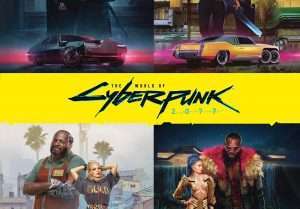 I really enjoyed Cyberpunk 2077, for the most part, as the storytelling as well as visuals went a long way to overcoming the numerous bugs present within. Indeed, as something of a lore junkie, I was determined to immerse myself in the weird and amazing world of the alternate timeline presented within. A world where the Soviet Union never fell, environmental devastation destroyed much of the Earth, and megacorporations had emerged as nation-states that controlled much of the planet’s economy.
I really enjoyed Cyberpunk 2077, for the most part, as the storytelling as well as visuals went a long way to overcoming the numerous bugs present within. Indeed, as something of a lore junkie, I was determined to immerse myself in the weird and amazing world of the alternate timeline presented within. A world where the Soviet Union never fell, environmental devastation destroyed much of the Earth, and megacorporations had emerged as nation-states that controlled much of the planet’s economy.
This is a delightfully detailed world that has a lengthy history, description of the various factions, and the geo-political situation of the world that is largely only hinted in the game proper. For example, Militech was nationalized after the events of the Fourth Corporate War and used to help rebuild the United States of America but has since undermined control of the restored government to take it over from the inside.
However, that sort of gets into the primary problem of the book. Specifically, before you shell out twenty dollars for this full color and fascinating book (both the Kindle as well as hardback cost the same), you must ask yourself “How much do I love Cyberpunk 2077?” Because that is certainly a question you should ask for this book. Because you’re not getting any story here, only details about a world that exists only in a video game right now. If you’re the kind of person who loves art books to movies or sitting down to read The History of Hyrule, Onward Arasaka Soldier, but this is going to be essentially like paying for a beautifully illustrated few hours on the game’s wiki.
The art is spectacular in this book with a lot of images that help bring to world the satirical and hilarious world of Night City. Indeed, I’d say the book does a better job of realizing the setting than the proper game itself. I feel like if you’re a fan of Cyberpunk 2077 or plan to run Cyberpunk RED then this is a book to pick up. If you aren’t fascinated by the deep lore and mythology of either, then this book is probably not for you. There’s no story or plot but just description of how the setting works as well as its history.
However, I do think this book works well as a supplement for the video game if you plan on doing a “deep dive” of roleplaying for it. A lot of the in-game material to appreciate Cyberpunk 2077 are done on Shards that are hard to read or in “blink and miss it” discussions. This assembles a large part of the setting’s lore and presents in a very well-organized fashion that will allow a player character to understand not just who Arasaka as well as Militech are but what the consequences of Johnny Silverhand’s nuke were.
In conclusion, I got my money’s worth, but I am a huge cyberpunk fan. I read it, I watch it, and I play it both on tabletop as well as in video games. I’m specifically a fan of the setting too. So, let the buyer beware. Still, the book is gorgeous and full of excellent satire as well as well-reasoned world-building. Mike Pondsmith must be proud.
Read The World of Cyberpunk 2077The post REVIEW: The World of Cyberpunk 2077 appeared first on Grimdark Magazine.
September 23, 2022
REVIEW: Cyberpunk: Edgerunners
I had a lot of hope for the 2022 anime season, but to be perfectly honest had spent most the year being disappointed.
Until Cyberpunk: Edgerunners dropped.
Based on the best-selling videogame Cyberpunk 2077, which in turn is based on the TTRPG Cyberpunk created by Mike Pondsmith, Edgerunners is created and animated by Studio Trigger, an animation studio best known for their ultra stylized aesthetics and mind shattering sakuga. Edgerunners delivers on it all, too. From the very first episode, from the very first moment that episode begins, its next to impossible to look away from. The screen, every moment, every scene, is packed with something going on, something awesome to look at. For fans of the Cyberpunk 2077 video game, there’s more easter eggs and homages than you might be able to catch in a single watch.
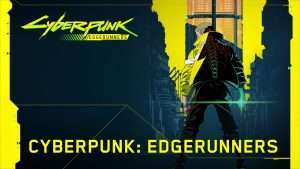 Trigger is absolutely firing on all cylinders with Edgerunners, delivering what—as far as I’m concerned—is a strong contender for “Anime of the Year.” From the writing, which tells the tragic rise and fall of a young edgerunner (that’s slang for merc) in Night City and life in the city, their crew, their ups and downs, their triumphs and defeats, to the absolutely awesome sound design and soundtrack (honestly, the OP is a banger and every single episode is jam packed with excellently chosen tracks that go a long, long ways towards drawing a viewer in and enhancing the experience) and everything in between. The direction and animation are, of course, incredible. Some of the best that Studio Trigger has delivered in recent years, with many instances feeling like call-backs to some of the hardcore cyberpunk OVAs of the 90’s like Bubblegum Crisis, AD Police Files and other rad and infamous anime. Episode 6, in particular (“Girl on Fire”) is probably the single best anime episode I’ve seen all year and it was so good that when it was done I sat down and watched it again. Something about it. It’s…special. Singular. Even the animation in that episode feels separate from the rest of the series, like it’s even more heavily stylized—it’s the episode that’ll break your heart. In a series of moments that land like blows to the heart.
Trigger is absolutely firing on all cylinders with Edgerunners, delivering what—as far as I’m concerned—is a strong contender for “Anime of the Year.” From the writing, which tells the tragic rise and fall of a young edgerunner (that’s slang for merc) in Night City and life in the city, their crew, their ups and downs, their triumphs and defeats, to the absolutely awesome sound design and soundtrack (honestly, the OP is a banger and every single episode is jam packed with excellently chosen tracks that go a long, long ways towards drawing a viewer in and enhancing the experience) and everything in between. The direction and animation are, of course, incredible. Some of the best that Studio Trigger has delivered in recent years, with many instances feeling like call-backs to some of the hardcore cyberpunk OVAs of the 90’s like Bubblegum Crisis, AD Police Files and other rad and infamous anime. Episode 6, in particular (“Girl on Fire”) is probably the single best anime episode I’ve seen all year and it was so good that when it was done I sat down and watched it again. Something about it. It’s…special. Singular. Even the animation in that episode feels separate from the rest of the series, like it’s even more heavily stylized—it’s the episode that’ll break your heart. In a series of moments that land like blows to the heart.
I could probably go on for a few hundred words at least about each episode, about the characterization, about how just truly well done the entirety of Edgerunners is but to be perfectly honest it needs to be experienced totally fresh so I’m endearing to keep this review as utterly free of anything resembling spoilers as possible. Whether or not you know anything about the video game, or the TTRPG that inspired it and the anime, the show is a masterclass in delivering an animated series as a total package. If you do happen to be a fan of the video game or RPG, you’ve got a lot to look forward to because every single episode is bursting at the seams with content pulled straight from the world of Cyberpunk, and it is a living, breathing, thriving, beautiful, horrible world.
In the time since Cyberpunk: Edgerunners has dropped, I spent a while looking up reviews on other sites and going over how they’ve deep dived it, hyper analyzed it, picked it apart and gone through it. And while many of them have fantastic things to say about it (and of course some negatives—you can’t escape those and I’m not going to say it’s perfect, either), I think the number one thing to take away is this: jack in. Do the deep dive. Don’t hold back. If you can, binge it hard all in one sitting and roll around in it. Edgerunners is the kind of show that doesn’t come around very often and we’re super fortunate to have gotten it. Whether or not it gets any kind of follow-up season is, at this time, unknown. Does it need one? Not really. Not when what we got is so damn good already.
The post REVIEW: Cyberpunk: Edgerunners appeared first on Grimdark Magazine.
September 22, 2022
REVIEW: Watch Dogs Legion: Daybreak Legacy
Watch Dogs: Legion was a video game with a fantastic premise that was undermined by poor systems handling. The post-Brexit London turned to a fascist dystopia by a false flag operation arranged by unknown forces was basically V: For Vendetta crossed with Cyberpunk.
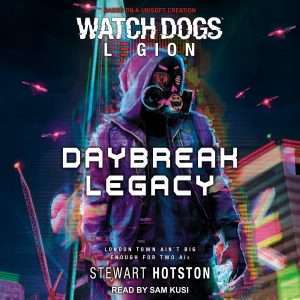 There are a lot worse combinations you can turn to in order to have an interesting video game premise. Unfortunately, the lack of a concretely written protagonist crippled the storytelling potential of the game as since you could be anyone in the game, you ended up being no one.
There are a lot worse combinations you can turn to in order to have an interesting video game premise. Unfortunately, the lack of a concretely written protagonist crippled the storytelling potential of the game as since you could be anyone in the game, you ended up being no one.
Watch Dogs: Legion: Bloodlines went a long way to correcting the flaws of the game and I frankly don’t recommend playing the game without this DLC. It provides Aiden Pearce and Wrench as protagonists who, while not substantially different from the randomly generated characters, have a prequel introduction to the game world that gives it enough emotional weight to be enjoyed. Plus, both of them are badass enough that you can alternate between them to enjoy the whole game.
Daybreak Legacy is an epilogue novel to the video games and follows up the events about six months into the future. Video game fiction rarely pays attention to narrative like this and I appreciated this aversion. However, video game literature is rarely high art and I was skeptical this could be an interesting example of the cyberpunk genre.
Surprisingly, the book proves to be much better than I expected. The premise is that the Albion PMC has been driven from London and the country is slowly returning to “normal” but an accent on the slowly. The chaos of losing their dictatorship has attracted all sorts of looters, bad faith actors, and profiteer to the city that Deadsec is unable to deal with due to their own need to look after themselves.
The book proceeds to raise the possibility that Skye Larsen, a tech billionaire pursuing immortality, has survived the events of the game and become an AI menacing the city. It actually becomes a much more complicated story with questions of AI, ethics, transhumanism, and questions of how to resist fascism in the real world.
The book doesn’t have Aiden Pearce or Wrench or any other recognizable characters in its pages. They aren’t even mentioned. However, the events of the main game are referenced several times with statements this branch of DeadSec isn’t familiar with all the others. Indeed, these characters are actually the protagonists of the previous book, Zero Day, so you might want to read that. Unfortunately, that wasn’t that great of a book to begin with.
Really, the best part of Daybreak Zero is the fact that it does tackle a lot of interesting transhumanist questions and ideas. It also stars characters of color and deals with some of the issues that Watch Dogs: Legion danced around but didn’t directly choose to talk about like race as well as class in the United Kingdom.
If you really liked the main game, I think this is worth pursuing but if you didn’t then this isn’t something to check out. Still, it’s pretty good low-key cyberpunk fiction and I enjoyed the choice to use words over violence for the most part.
Read Watch Dogs Legion: Daybreak LegacyThe post REVIEW: Watch Dogs Legion: Daybreak Legacy appeared first on Grimdark Magazine.
September 21, 2022
REVIEW: Among the Masses by Phil Brucato
Despite the oftentimes morally murky morass that permeates the World of Darkness and its various games and supplements, there can be no question that true evil does exist within it—much like within our own world. Oftentimes, though, as in the real world, that evil is subtle. Insidious. Existing right next to you. With the 20th Anniversary edition of Mage: the Ascension, Phil Brucato brought the mind bending game of the war for reality screaming into modern nights. This included quite a bit of updating, but also a whole host of new supplemental material and books including The Book of the Fallen, a sinister tone which gave us our most horrifically in-depth look to day at the nightmarish servants of annihilation and corruption: the Nephandi. It was not a book for the faint of heart, but it was one of my favorite World of Darkness books in years and one of the best that Phil Brucato has ever written.
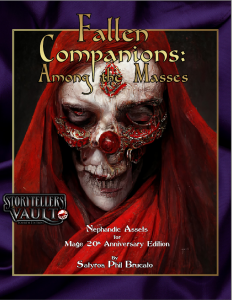 Intended as a companion piece and partially created using material that couldn’t quite fit into The Book of the Fallen, Among the Masses is a companion piece that further explores the Fallen world and—if anything—manages to paint certain aspects of that world in an even darker shade of black. Among the Masses doesn’t deal with the magical, the supernatural, or the esoteric. At least, not in any truly direct fashion. It deals with the human. With the low, the broken, the lost; the ones that the Fallen use as puppets, that they manipulate and extort. Among the Masses presents us with a portfolio of resources to add layers of depth to a game, templates for NPCs to create more elaborate and fleshed out interactions. But it also gives us a raw-boned, unflinching examination of how the characters and situations within the pages of Among the Masses come to exist to begin with. Make no mistake, some of the content is rough. A lot of it might make you uncomfortable. It’s the World of Darkness, after all, not the World of Sunshine, and Among the Masses takes us to some of the darkest corners of that world. It’s frighteningly effective because so much of it is relatable and understandable on a personal level.
Intended as a companion piece and partially created using material that couldn’t quite fit into The Book of the Fallen, Among the Masses is a companion piece that further explores the Fallen world and—if anything—manages to paint certain aspects of that world in an even darker shade of black. Among the Masses doesn’t deal with the magical, the supernatural, or the esoteric. At least, not in any truly direct fashion. It deals with the human. With the low, the broken, the lost; the ones that the Fallen use as puppets, that they manipulate and extort. Among the Masses presents us with a portfolio of resources to add layers of depth to a game, templates for NPCs to create more elaborate and fleshed out interactions. But it also gives us a raw-boned, unflinching examination of how the characters and situations within the pages of Among the Masses come to exist to begin with. Make no mistake, some of the content is rough. A lot of it might make you uncomfortable. It’s the World of Darkness, after all, not the World of Sunshine, and Among the Masses takes us to some of the darkest corners of that world. It’s frighteningly effective because so much of it is relatable and understandable on a personal level.
As a game resource, Among the Masses is a quick read but not a light one by any means. It is immensely useful, though, and not just for a Mage chronicle. It is applicable across the board for any of the game lines in the World of Darkness, and I’d highly recommend it to any Storyteller looking to add more hooks and complications to their games, add more layers to the NPCs their characters interact with. It gives the Storyteller a more functional understanding of the kind of individuals that might be working against the players and their characters, but also individuals that might most be in need of saving and how they can be saved—or drag the world down around them.
All in all, whether you’re looking for something to supplement your Mage game or any other World of Darkness chronicle and you’ve got the wherewithal to stand going to some of the uglier places to get it, I cannot recommend Among the Masses more highly. It more than earns a solid four out of five stars, and for the discerning Storyteller, will make you look at the characters you may consider “the bad guys” in a whole new light.
The post REVIEW: Among the Masses by Phil Brucato appeared first on Grimdark Magazine.
September 20, 2022
REVIEW: Middle Earth: Shadow of War
Middle Earth: Shadow of War is the sequel to the highly popular and enjoyable Middle Earth: Shadow of Mordor. It was a somewhat blasphemous and fascinating take on the classic Tolkien Legendarium, having its protagonist seek to use necromancy as well as other dark magic to fight the Dark Lord with his own power. You know, the one thing that is constantly warned against by Tolkien as self-defeating but we kind of would be curious as to how it would go.
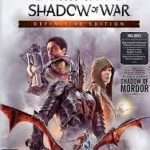 Since this is a direct sequel, a brief recap is warranted: Talion is a Ranger of the North without the powerful blood of Numenor running through his veins. After a sneak attack by Sauron’s forces, he ends up being possessed by the elven smith Celebrimbor. Talion manages to do a good deal of damage to Sauron’s war machine but the realization that the Dark Lord is just getting started is enough to get him to convince Celebrimbor to make a new ring.
Since this is a direct sequel, a brief recap is warranted: Talion is a Ranger of the North without the powerful blood of Numenor running through his veins. After a sneak attack by Sauron’s forces, he ends up being possessed by the elven smith Celebrimbor. Talion manages to do a good deal of damage to Sauron’s war machine but the realization that the Dark Lord is just getting started is enough to get him to convince Celebrimbor to make a new ring.
The game starts immediately after Talion sneaks into Mount Doom and proceeds to smith himself a ring with Celebrimbor’s help. I would have actually enjoyed sneaking into Mount Doom and am a bit disappointed that Talion didn’t have to do so. Either way, Celebrimbor pours his life force into the New Ring (along with yours) but has it almost immediately stolen. This is meant to explain why Talion goes from an orc-slaying badass Ringwraith to a complete weakling again but also actually fits the fact the Rings of Power can never be trusted.
Unfortunately, this is also where the story starts to go completely off the rails and never quite gets back on them. Specifically, the New Ring is stolen by Sexy Shelob. Yes, the giant spider who almost ate Frodo. Apparently, she can assume a form that can best be described as “Morrigan from Dragon Age in an evening dress.”
Much has already been made of this bizarre lore change, somewhat akin to Godzilla becoming a hot Japanese school girl, but I could meet them halfway on this. Plenty of mythological creatures assume the form of sexy women to eat people because ancient peoples had serious issues with misogyny: vampires, sirens, succubi, kelpies, deer women, and so on. It’s just Shelob doesn’t have her one characterization trait and instead works as a kind of anti-Galadriel, putting Talion on the road to destroying Sauron. Because, apparently they used to date.
Oh sweet Eru.
No.
Seriously, you have no idea how badly you must screw with the lore to get me to not support more pale raven-haired witches in fiction. Not saying it’s a fetish but it’s a fetish. Anywho, Talion has to use his unholy powers, diminished as they are, to try to help protect Minis Ithil from an invasion of orcs. I mean, technically the citadel should have fallen a thousand years before, but this Sauron is just getting started.
Talion meets a cute pint-sized Eowyn named Idril, her Haradrim captain, and father before asking, “Could I please have your palantir because the ghost in my head wants it before Sauron gets it?” This goes poorly and becomes a bickering conflict between Talion wanting to save lives and Celebrimbor seeking absolute power to defeat Sauron.
The story is pretty complex and spread across multiple zones of Mordor. Some of the ideas are quite interesting as you apparently meet an Ent-Wife (or their patron Maia), you have to deal with a cult of necromancers, contend with a Balrog waking up, and finally have the Nazgul introduced since Sauron is well and truly tired of Talion/Celebrimbor’s bullshit.
Frankly, some of these would have made pretty good games themselves and I kind of think it’d have been hilarious if instead of Sexy Shelob, they’d made Durin’s Bane be the beautiful woman who stole Celebrimbor’s ring. That would have been ridiculous but not necessarily lore breaking. Who says the Balrog can’t be female? Plus, as a Maia, the idea they can assume a human form goes with the territory. She’d probably be a redhead, though.
Sadly, the weird lore breaking gets even worse as the game goes on as we find out the identities of the Nazgul like Helm Hammerhand, Isildur, and a group of Chinese-themed twin sisters (DLC only). There’s also a guy who was clearly meant to be Al-Pharazon but they changed his name, which is about the only smart move they did. This is just silly because the people who know who these people are don’t want to see them stuck with entirely different characters. It’s like revealing Darth Revan’s true identity was Luke Skywalker all along. Even if you explain that he was transported back in time via a wormhole, that doesn’t make it less stupid.
Unfortunately, as silly as the world-building is and the game’s inability to commit to any of its interesting ideas (I’d happily play an entire game of Talion versus a Balrog), the storytelling is by far the best part of the game. The gameplay is decent but the attempt to make it a much-larger open world game and introduce base management elements doesn’t really improve it. The previous game benefited fantastically from the Nemesis System where artificially generated orcs are used to harass Talion, but this has a lot more predetermined ones that are less interesting. There’s also a lot more of them so by the time you’ve killed your 50th Captain, you’re kind of sick of them.
Perhaps the most egregious of trying to push the gamers into unnecessary time-wasting content is that to get the “true” ending, you must do ten sieges of your bases by Sauron’s forces. Sieges are not particularly enjoyable, and these are lacking in any form of story. It’s just time-wasting busy work for a short cutscene that should have been at the end of the game anyway.
I feel like the game doesn’t make use of its set pieces very well, either. You have an entire mission chain in the area around Mount Doom and you never get to go inside but for the New Ring forging scene. The New Ring’s powers are also not particularly well-defined with mind-control being an ability you had in the previous game. I feel like when introducing something like a new Ring of Power, you need to be a little more grandiose in your ambitions. There was more to complain about the game, like loot boxes, but, thankfully, the developers removed those.
In conclusion, Middle Earth: Shadow of War suffers from the fact that they wanted to appeal to the broadest audience possible and that meant making some very big compromises in the lore. I like the original characters for the most part and wouldn’t have had a problem if they had just made Sexy Shelob into another previously unknown fallen Maia. It’s already fanfic with Talion and company, that doesn’t mean it has to be bad fanfic. It’s still a lot of fun playing this game, branding orcs and mind-controlling them, but it’s not as fun as its predecessor due to the slog as well as attempts to push the sieges as a main gameplay element.
Play Middle Earth: Shadow of WarThe post REVIEW: Middle Earth: Shadow of War appeared first on Grimdark Magazine.
September 19, 2022
August 2022 comic books review
Grimdark covers an immense range of content. It’s as much a style and aesthetic as it is a genre, or subgenre. The morally ambiguous underpinnings of grimdark, its penchant for the brutally violent and the blackest gallows humor, can be found across an impressive spectrum of media.
Like comic books, and right now in the world of comics there are more stories being told than possibly any other time before. So some of Grimdark Magazine’s writers enamored with comics have taken it upon themselves to start a dialogue and share their thoughts on what they think are the hottest, most exciting grimdark comics coming out from comic publishing houses big and small.
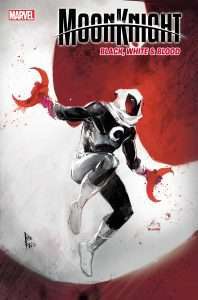 Moon Knight: Black, White, and Blood #4 (MARVEL)Paul Azaceta (W/A), Christopher Cantwell (W), Nadia Shammas (W), Alex Lins (A), Dante Basianoni (A)
Moon Knight: Black, White, and Blood #4 (MARVEL)Paul Azaceta (W/A), Christopher Cantwell (W), Nadia Shammas (W), Alex Lins (A), Dante Basianoni (A)The final installment in Marvel’s most recent run of Black, White, and Blood books, we get an unflinching—even momentarily heartbreaking—look into the harrowing psychology of Marc Spector, aka Moon Knight. Each of the book’s three stories are their own kinds of brutal examinations into the inner world of the titular character, illustrated in stark, limited palettes to gorgeous effect by some seriously talented artists. While the entire limited series has been fantastic, this issue is an excellent finale that drives home Moon Knight’s recent rise in popularity.
Read Moon Knight: Black, White, and Blood #4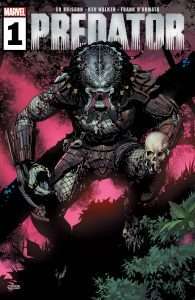 Predator #1 (MARVEL)Ed Brisson (W), Kev Walker (A)
Predator #1 (MARVEL)Ed Brisson (W), Kev Walker (A)With Marvel securing the publishing rights to Predator, this one has been a long time coming and the fandom has been eagerly awaiting its arrival. Thankfully, it was worth the wait. An original story set in the world of Predator, it’s a bloodthirsty scifi romp set in the not-too-distant future following the trail of a protagonist on a quest for vengeance against the alien that took everything away from her. A real page turner, with white hot action and stunning art, the new Predator series is definitely one to keep an eye on.
Read Predator #1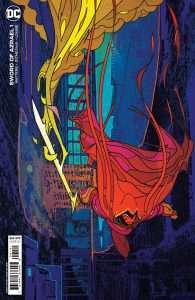 Sword of Azrael #1 (DC)Dan Watters (W), Nikola Cizmesija (A)
Sword of Azrael #1 (DC)Dan Watters (W), Nikola Cizmesija (A)What’s not to love about a half-mad vigilante possessed by what may or may not be an avenging angel? Azrael’s long been one of the more broken, intriguing characters from Batman’s menagerie of antagonists and accomplices, and Sword of Azrael shines the spotlight on him in what comes swinging hard into the ring straight from the first page. It’s a murder mystery, an esoteric conundrum, and a psychological thriller all rolled up into one fantastic, bloody good time.
Read Sword of Azrael #1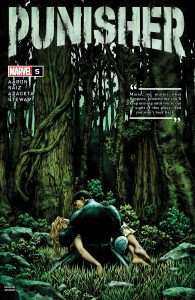 Punisher #5 (MARVEL)Jason Aaron (W), Jesus Saiz (A), Paul Azaceta (A)
Punisher #5 (MARVEL)Jason Aaron (W), Jesus Saiz (A), Paul Azaceta (A)The most recent incarnation of Punisher was met with a heaping helping of controversy before it ever hit the shelves thanks to, of all things, a logo redesign. That being said, Jason Aaron is at his best when he’s working on a singular character study and here in the pages of Punisher we get one of the most stark and horrific glimpses into the man behind the skull and his secret origins. It’s bloody, it’s awful, it’s as grim and as dark as you’d ever expect it to be and every issue ends entirely too damn soon.
Read Punisher #5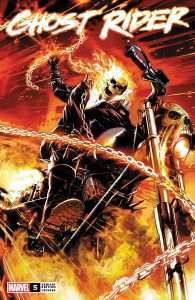 Ghost Rider #5 (MARVEL)Benjamin Percy (W), Cory Smith (A)
Ghost Rider #5 (MARVEL)Benjamin Percy (W), Cory Smith (A)Speaking of old series given new legs, the most recent run of Ghost Rider has been a consistent treat that’s giving us Johnny Blaze at his lowest in episode tales of terror and the infernal. It’s murder and mayhem, demons and the deranged, an overarching supernatural conspiracy to solve the mystery of Johnny’s lost time, but overall it’s a hell of a good read (pun fully intended). The format for this issue, basing the whole thing around a race, was brilliant and kept the action moving at a breakneck pace that made it impossible to quit turning the pages or catch your breath. Get a hold of this series now, and hold on for dear life.
Read Ghost Rider #5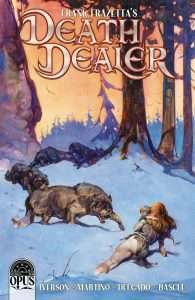 Death Dealer #4 (OPUS)Mitch Iverson (W), Stefan’s Martino (A)
Death Dealer #4 (OPUS)Mitch Iverson (W), Stefan’s Martino (A)When I discovered that Death Dealer was going to be getting a new comic series I was through the roof excited. Frazetta’s creation could well be the visual ideal of everything that is grimdark, but more than that the world and the legendary surrounding the character are the best kind of fantastical absurd. It’s everything you love about fantasy and grimdark turned up to eleven, and the comic series takes that ball and runs wild with it. Each issue is unflinching, unapologetic, and shows no mercy with the brutality, the gore, the over the top outrageous nature of the titular character. It’s an incredible good time, and I dearly hope the new Death Dealer series sticks around for a while.
Read Death Dealer #4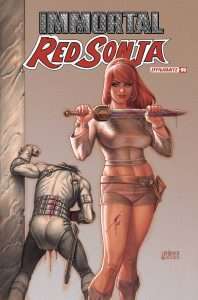 Immortal Red Sonja #5 (DYNAMITE)Dan Abnett (W), Alessandro Miracolo (A)
Immortal Red Sonja #5 (DYNAMITE)Dan Abnett (W), Alessandro Miracolo (A)As a huge Dan Abnett fan as well as a massive Red Sonja lover, I was very eager to get into the Immortal Red Sonja. Here, the comic is a somewhat peculiar combination of Arthurian myth as well as Sonja. Frankly, I feel that is a bit of a mistake as the Hyborian Age is 10,000 years in the past even if it does have Aquilonian knights. However, it’s still quite fun as poor Sonja is stuck with some magic chain mail that she is cursed to wear like a D&D artifact. It’s also intelligent, which is an interesting thing since it’s across her chest. Somehow even more perverse than the chainmail bikini. In any case, she is trying to get rid of the curse with the help of a semi-comatose Lancelot. Lots of fun twists and turns as well as a great cover. I also like the chainmail belly shirt look even if it’s no less silly than the chainmail bikini.
Read Immortal Red Sonja #5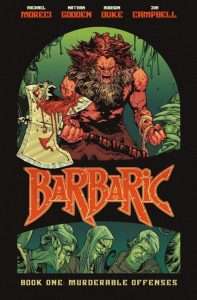 Barbaric (VAULT)Michael Moreci (W), Nathan Gooden (A)
Barbaric (VAULT)Michael Moreci (W), Nathan Gooden (A)Barbaric is a straightforward barbarian-style romp with the bonus of great humor and excellently drawn pages. It is entertaining and can be easily enjoyed on the second or third pass-through.
Barbaric stars Owen the Barbarian. A whoring and murderous bandit who ends up under a witches curse to make amends for his bloody past. Instead of a voice in his head or a friendly familiar to act as a moral compass, it is his bloodthirsty ax. The ax steals the show in this series with its witty banter and ways in which it would like to do damage.
“Henceforth, you live in servitude, and all the world is your Master. Any cry for help, any haven under siege, any beggar in distress you must aid.”
The irony of this story is that a weapon that can be used to cleave apart skulls and is dripping with bloodlust now needs to be checked by a barbarian, basically doing deep breath mantras to stay calm. But when he lets go, the gore and the sparks fly. Because sometimes, folks need to have their ass kicked, and Owen is delighted to help in that regard.
Because Barbaric does not tread any new material, as a matter of fact, it plays on some of the existing tropes for this kind of storytelling; this could have been hackneyed. But because of the level of humor and the inability to take itself too seriously, Barbaric is just plain fun. It is a leisurely afternoon read full of excellent graphics with an entertaining plot.
Vault, the publisher of the comic, is churning out quite a few delightful titles; it is the publisher to watch right now. Barbaric is the title for you if you are in the mood for an amusing story to crack a beer and kick back to. I will certainly be continuing it in the future with the series, beer in hand.
Read BarbaricThe post August 2022 comic books review appeared first on Grimdark Magazine.



